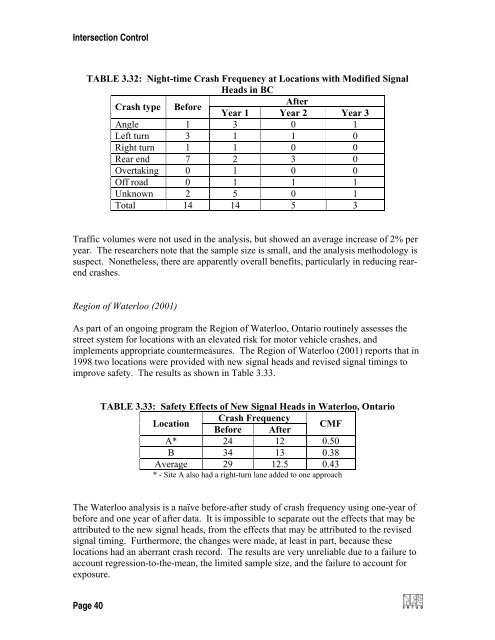Synthesis of Safety for Traffic Operations - Transports Canada
Synthesis of Safety for Traffic Operations - Transports Canada
Synthesis of Safety for Traffic Operations - Transports Canada
You also want an ePaper? Increase the reach of your titles
YUMPU automatically turns print PDFs into web optimized ePapers that Google loves.
Intersection Control<br />
TABLE 3.32: Night-time Crash Frequency at Locations with Modified Signal<br />
Heads in BC<br />
Crash type Be<strong>for</strong>e<br />
After<br />
Year 1 Year 2 Year 3<br />
Angle 1 3 0 1<br />
Left turn 3 1 1 0<br />
Right turn 1 1 0 0<br />
Rear end 7 2 3 0<br />
Overtaking 0 1 0 0<br />
Off road 0 1 1 1<br />
Unknown 2 5 0 1<br />
Total 14 14 5 3<br />
<strong>Traffic</strong> volumes were not used in the analysis, but showed an average increase <strong>of</strong> 2% per<br />
year. The researchers note that the sample size is small, and the analysis methodology is<br />
suspect. Nonetheless, there are apparently overall benefits, particularly in reducing rearend<br />
crashes.<br />
Region <strong>of</strong> Waterloo (2001)<br />
As part <strong>of</strong> an ongoing program the Region <strong>of</strong> Waterloo, Ontario routinely assesses the<br />
street system <strong>for</strong> locations with an elevated risk <strong>for</strong> motor vehicle crashes, and<br />
implements appropriate countermeasures. The Region <strong>of</strong> Waterloo (2001) reports that in<br />
1998 two locations were provided with new signal heads and revised signal timings to<br />
improve safety. The results as shown in Table 3.33.<br />
TABLE 3.33: <strong>Safety</strong> Effects <strong>of</strong> New Signal Heads in Waterloo, Ontario<br />
Location<br />
Crash Frequency<br />
Be<strong>for</strong>e After<br />
CMF<br />
A* 24 12 0.50<br />
B 34 13 0.38<br />
Average 29 12.5 0.43<br />
* - Site A also had a right-turn lane added to one approach<br />
The Waterloo analysis is a naïve be<strong>for</strong>e-after study <strong>of</strong> crash frequency using one-year <strong>of</strong><br />
be<strong>for</strong>e and one year <strong>of</strong> after data. It is impossible to separate out the effects that may be<br />
attributed to the new signal heads, from the effects that may be attributed to the revised<br />
signal timing. Furthermore, the changes were made, at least in part, because these<br />
locations had an aberrant crash record. The results are very unreliable due to a failure to<br />
account regression-to-the-mean, the limited sample size, and the failure to account <strong>for</strong><br />
exposure.<br />
Page 40
















